Facebook offers so many different ad types that it can be tough to know which one to use and when. With this guide, you’ll be able to navigate the various Facebook ad types (aka ad units), with an explanation of how they work and the benefits and drawbacks of each.
Facebook ad types can be confusing because there are many possible permutations of the three components of each ad unit:
- Campaign marketing objective (17 possible objectives)
- Placement (8 possible placements)
- Ad format (6 possible formats)
READ MORE
This guide will explain each of these components in detail and walk you through the options for each one. If you want to cut to the chase, scroll to the bottom of the guide where you will find a matrix of the different combinations of each component so you can create the right ad type for your Facebook marketing goals.
Campaign Marketing Objectives
It all starts with the marketing objective. Your campaign’s marketing objective will determine which placements and ad formats are available to use. This is important because you may not always get the ad format you want by choosing the true objective for your campaign.
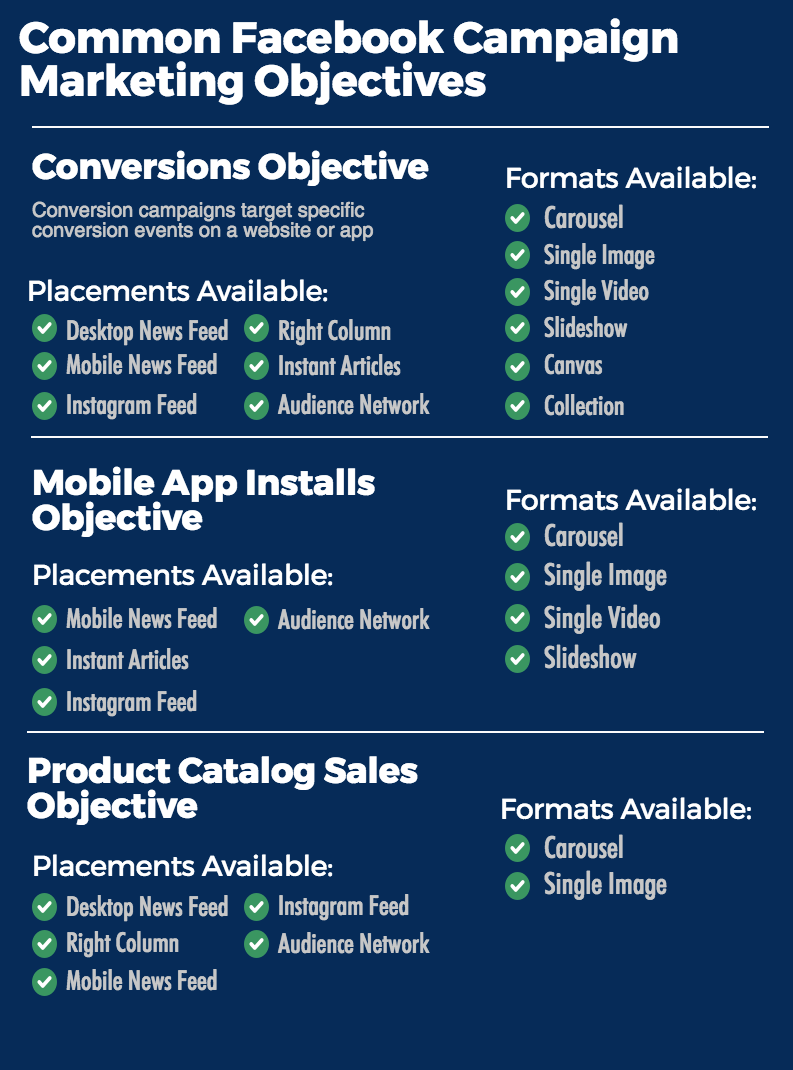
If you’re using the guided creation process in Ads Manager to create your campaign, the first thing you’ll see is a list of objectives that are divided into two tabs – Auction and Reach and Frequency. These represent your “buying type” options which establish how you want to buy advertising impressions from Facebook. This decision has no impact on which ad formats or placements will be available to you.
The “Auction” buying type is the most flexible and is recommended for the vast majority of advertisers who want to buy impressions on the open Facebook ad auction.
Reach and Frequency buying comes into play when you want predictability in terms of how many people you want to reach, how often you want them to see your ads, and how much you want to pay to reach them. You need to decide these inputs upfront with Reach and Frequency buying, and doing so isn’t conducive to making adjustments on the fly based on performance. Hence most advertisers choose the Auction buying type.
This guide will walk you through the “Auction” buying type. There are 11 marketing objective options when you select “Auction” buying:
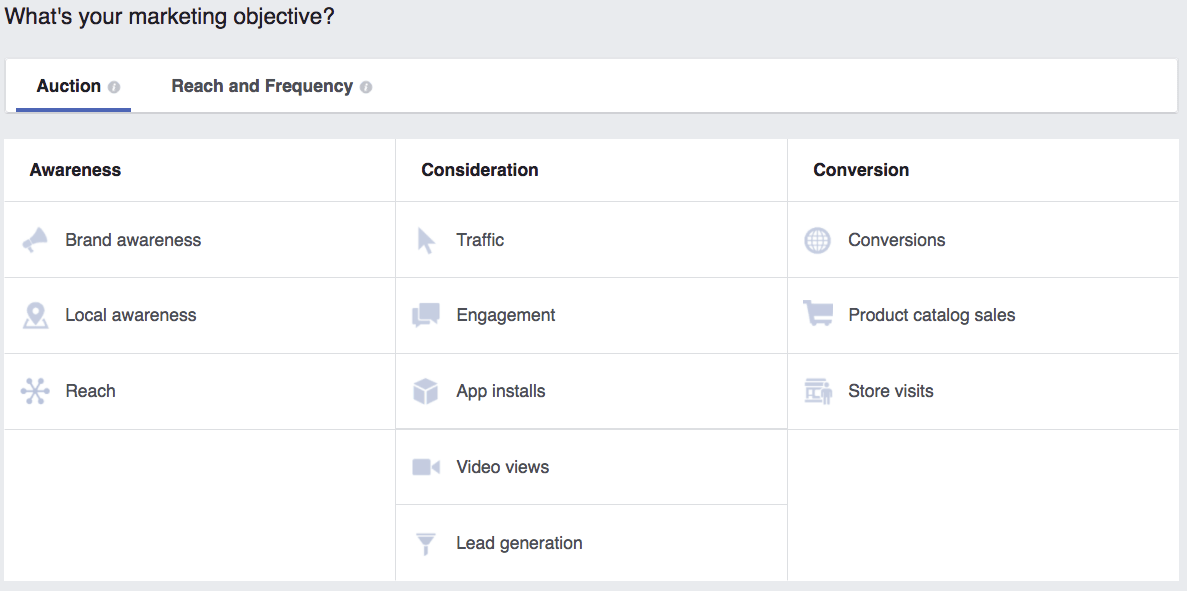
You can also access these objectives in Power Editor, which has a longer list with different options (17 total campaign marketing objectives).
Here’s the campaign marketing objective dropdown menu from Power Editor under the “Auction” buying type:
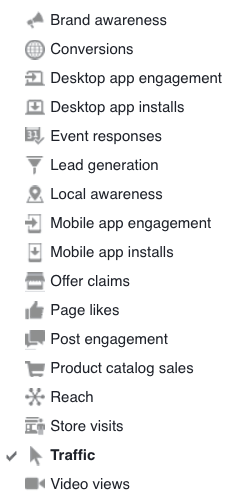
You might notice that the list of objectives in Power Editor is more extensive than what is shown in Ads Manager. Facebook likely omits some of these options in Ads Manager to make it easier for beginner advertisers to get started without overthinking the options. Most advanced Facebook advertisers use either Power Editor or some third-party management software, both of which are more robust than Ads Manager.
Each campaign objective yields different options for the placements and ad formats you can choose for ad creation. For example, an app install ad can’t be shown on desktop placements, and is limited to certain ad formats (single video, single image or carousel). Refer to the table at the end of this post for a full list.
The intended use case for each campaign objective is mostly self-explanatory, as it’s based on what you are trying to achieve with the campaign. If you want people to install your app, you would choose either desktop or mobile app install. If you want to capture leads, you would choose the “lead generation” objective, and so on. You can check out the Facebook Ads Guide for a basic overview of each campaign objective and what Facebook intends them to do (in theory).
When choosing a campaign objective, the best thing to do is reverse engineer it from the ad you want to create. If you want to create a link ad that drives clicks to a landing page on your website that shows on the Audience Network placement, for example, don’t choose the “App Install” objective which will eliminate that option. The table at the bottom of the guide is a great resource to help you do this.
Once you’ve narrowed down the list of campaign objectives by applying the filter of which ad format/placements you want to target, you’ll have fewer options to choose from and you can make a strategic decision from there. Based on our experience, we recommend using the Conversions” objective whenever possible as it tends to perform better.
Placements
The second component of Facebook ad types is placements. As we’ve discussed, only certain placements are available for each campaign objective. However, strategically choosing placements for your ads can be critical to their performance.
At present, there are a total of 8 possible placements. This number will likely continue to expand as Facebook rolls out new products and features.
1. Desktop News Feed
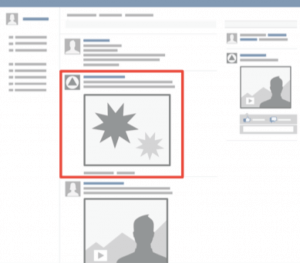
The Desktop News Feed placement is fairly self-explanatory. Selecting this placement will put your ad in an auction for Facebook News Feed inventory on desktop devices.
Pros
Desktop News Feed is one of the most sought after ad placements. That’s because it tends to have high CTRs due to the amount of real estate a Desktop News Feed ad occupies.
Desktop News Feed is also very conducive to conversion as desktop users tend to have more follow through than mobile users. Checkouts, lead captures or other online transactions requiring users to give up their information are getting easier and easier on mobile, but it’s still usually easier to enter your credit card information on your desktop computer than it is on your iPhone.
Cons
Desktop News Feed has some drawbacks as well. A majority of News Feed impressions on Facebook are now on mobile, with our internal data showing that more than 80% of impressions come from mobile on average across our clients. In addition, a growing majority (56.5%) of Facebook users are mobile-only, so if you are only targeting desktop devices you are missing out on a lot of eyeballs. CPCs on desktop are also high due to competition from advertisers vying for higher-converting desktop impressions.
2. Mobile News Feed
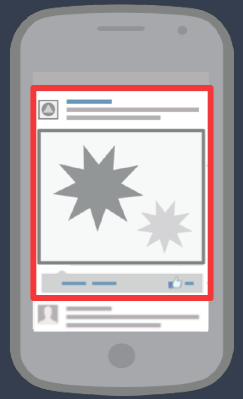
The mobile News Feed placement is the same as the desktop News Feed placement, except on mobile devices.
Pros
As with desktop News Feed, Mobile News Feed has high relative CTRs. It also has a lot of available ad inventory, as a majority of Facebook users spend most of their time on mobile. Lastly, CPCs on mobile are lower relative to desktop.
Cons
The problem with Mobile News Feed is greater user dropoff once they’ve actually entered the funnel. Mobile users are typically on the go, meaning lower attention spans and follow-through. In addition, mobile checkout flows/landing pages are usually less user-friendly. This all leads to lower conversion rates stemming from the Mobile News Feed placement.
3. Instant Articles
Instant Articles are fast-loading articles that display directly within the Facebook News Feed on mobile devices, allowing publishers to show content without needing to take Facebook users to an external app or website. For content publishers who opt their Instant Articles into the Facebook Audience Network, Facebook ads will be displayed within the article. This is the Instant Article ad placement.
Pros
The Instant Articles placement is good for remarketing as it represents one more opportunity to cheaply deliver an additional touch point to a user in the funnel. Inventory for this placement tends to be less expensive than most other placements.
Cons
Conversion rates are generally low for Instant Article ads and there isn’t much inventory available yet as it’s relatively new. Additionally, there aren’t optimization levers to choose specific publishers or articles at this point – relinquishing control of delivery entirely to Facebook.
4. In-Stream Videos
In-stream video ads are a relatively new ad placement that includes pre-roll, mid-roll, or post-roll video ads that advertisers can serve to videos on third-party sites and apps that are plugged into Facebook’s Audience Network. In-stream video ads are available for both desktop and mobile. Note that the name of this placement “in-stream video” ads, is drawn from Facebook’s official terminology.
Pros
Video advertising is growing rapidly and the in-stream video placement expands the amount of available inventory for video ads, with Facebook reporting 10% more incremental reach than mobile News Feed alone. Additionally, Facebook conducted early tests that indicate lower cost per impressions through this placement.
Cons
One drawback of the in-stream video placement is that conversion rates are generally low as audiences tend not to be as qualified, as with other Audience Network ads. The inventory is also small as it’s a recent addition to the Facebook advertising suite.
5. Right Column
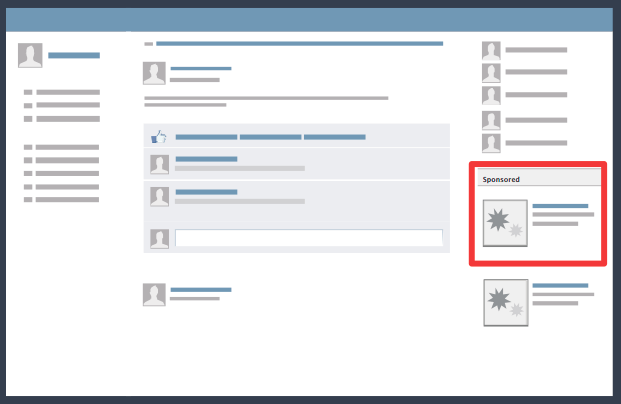
The right column placement is available on desktop only.
Pros
A big plus for Right Column ads is that impressions are cheap, even though these ads have a much higher average time on screen than News Feed ads (which are scrolled past quickly, whereas Right Column ads are relatively static Right Column placement ads tend to see a higher number of view-through conversions, which can partially be explained by the high duration of time on screen.
Cons
The problem with Right Column ads is low CTR relative to other placements. As a consequence of fewer clicks, click-through conversions are rare, which can be a big drawback for advertisers that don’t value view-through conversions.
6. Instagram Feed
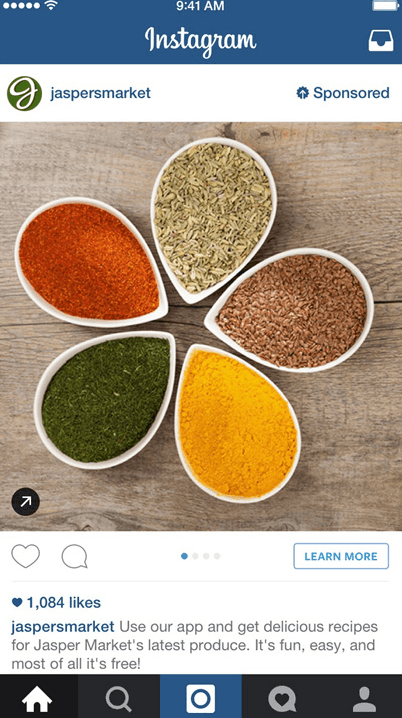
Although Instagram is an entirely separate platform from Facebook, it’s tied to users’ Facebook accounts and is integrated with the Facebook advertising platform. The Instagram feed ad placement is available on mobile only.
Pros
Instagram is a highly visual medium which can be very beneficial for advertisers with visually attractive or compelling products.
In addition, an Instagram advertising benchmark report from last year proclaimed higher-quality clicks due to more rigorous standards for what counts as an ad click on Instagram, implying that Instagram ads drive more qualified traffic. Our internal findings tend to support this.
Lastly, Instagram users tend to spend more (higher average order value) for eCommerce than Facebook users.
Cons
Instagram CPCs tend to be higher than other placements. According to the 2016 Instagram advertising benchmark, Instagram had a $1.41 average CPC vs $0.50 on Facebook.
CTRs also tend to be lower on Instagram when compared to Facebook according to the report, with a 0.4% Instagram CTR vs a 1.3% Facebook CTR. And there are a lower total number of users on Instagram than Facebook (300 million DAU vs 1.13 billion DAU on Facebook), limiting reach.
7. Instagram Stories
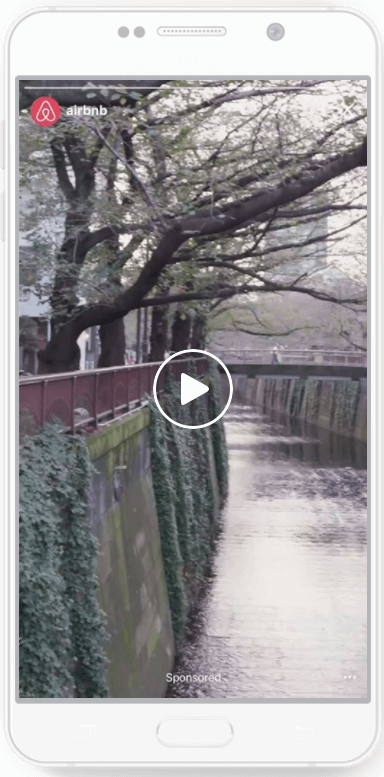
The Instagram Stories ad placement is very new, having launched for all advertisers on March 1, 2017. These are full-screen, skippable ads that show up in Instagram’s (also new) Stories feature, and it is too early to tell conclusively how performance stacks up to other placements.
This placement is only available through the dedicated Instagram business manager, not through the Facebook ads platform, so keep that in mind if you want to test out this placement for your account.
8. Audience Network
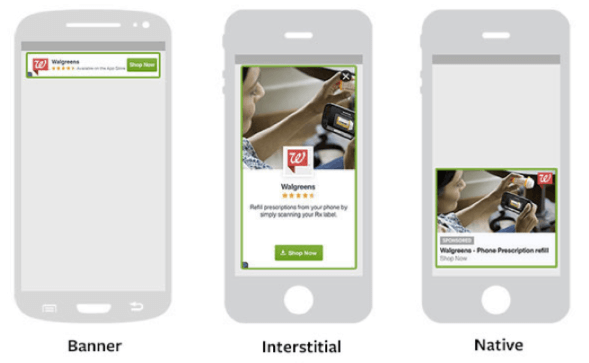
The Facebook Audience Network (FAN) consists of mobile publishers and app developers that have reserved some of their ad inventory for Facebook ads., These third-party publishers host Facebook ads which can be targeted at Facebook users using Facebook targeting options even when they’re not on Facebook, which is extremely powerful.
Facebook Audience Network ads take the form of banner, interstitial, or native ad units and are only available on mobile (for now).
In Facebook’s words:
“Audience Network lets you extend your ad campaigns beyond Facebook to reach your audiences on mobile apps, mobile websites and videos. We use the same Facebook targeting, measurement and delivery to make sure each ad on Audience Network helps you reach your campaign goals at the most cost-effective price.”
Brands that wish to exclude specific domains and apps can do so, but unlike Google Display Network there is no reporting by domains or apps so it’s less helpful from an optimization standpoint.
Pros
The Audience Network receives a lot of impressions at a very low price. Also, the FAN tends to have very low CPCs relative to other placements.
Cons
Like Google’s display network and other third-party display inventory, the FAN carries with it low conversion rates due to often unqualified traffic which leads to higher relative CPAs.
Ad Formats
The final component of Facebook ad types is ad format. There are currently 6 available ad formats for Facebook ads.
1. Carousel
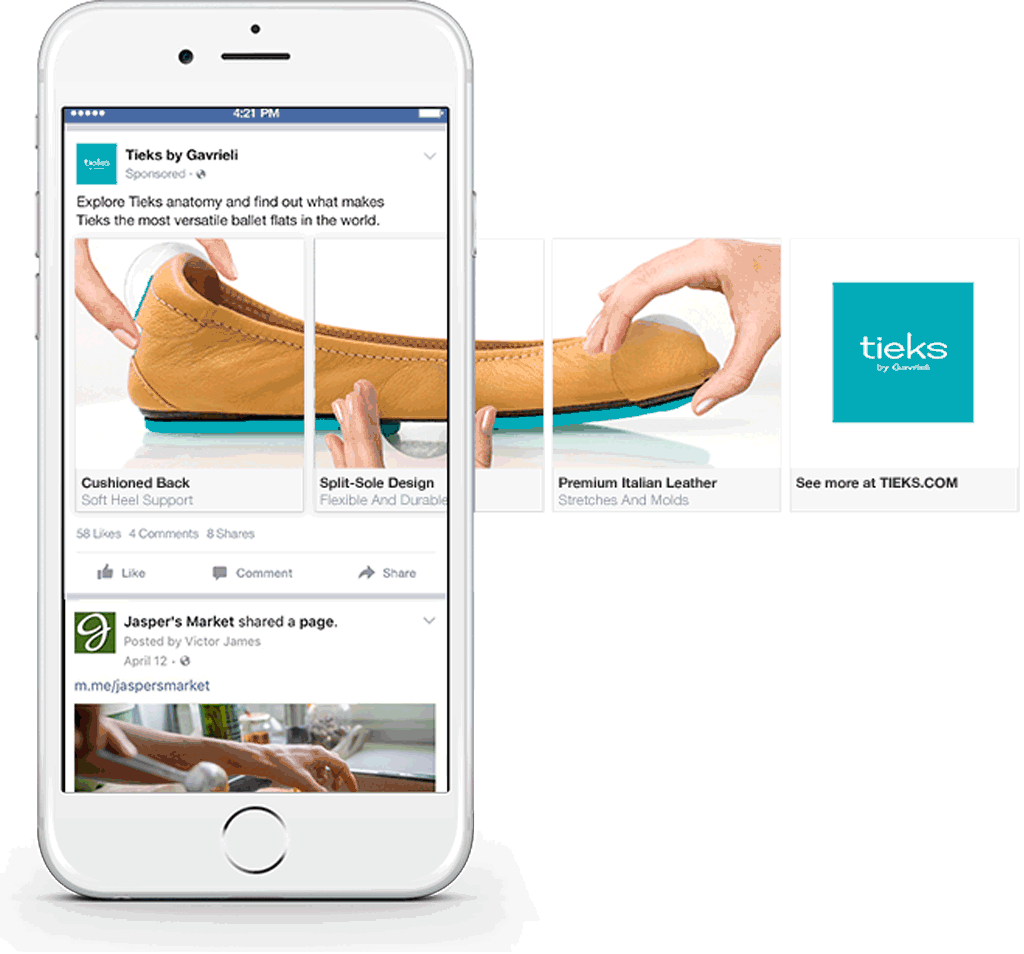
The carousel ad format is available on both desktop and mobile, and lets you post multiple cards (3 to 5 on Instagram and up to 10 on Facebook) containing either images or videos within the same ad unit. Users can then scroll through the ad to view all the cards. This format requires at least 2 images or videos.
The carousel format is especially useful for eCommerce advertisers with many product offerings they want to showcase, and also for advertisers that want to use one big continuous image broken up into sections (if it won’t fit in the Single Image ad format).
Carousels are also good for a complex product like as a SaaS analytics platform, because you can create a narrative with the images that explain what the product does and why it’s valuable.
Carousel Format Specifications
Here are the recommended image specifications for carousel images, according to Facebook:
- Recommended image size: 1080 × 1080 pixels
- Recommended image ratio: 1:1
- To maximize ad delivery, use an image that contains little or no overlaid text.
For carousel videos, the recommended specifications are:
- Recommended format: .mp4, .mov or .gif
- Resolution: at least 720p
- File size: 2.3 GB max
- Recommended aspect ratio: square (1:1)
- Facebook: 60 minutes max
- Instagram Feed: 60 seconds max
2. Single Image
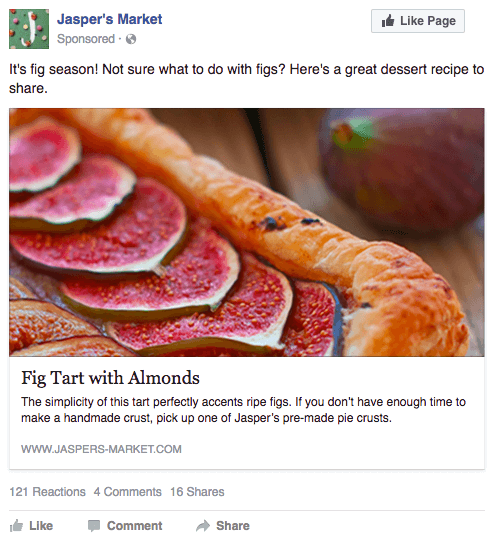
The Single Image ad format is just what it sounds like: a Facebook ad with a single image as the ad creative. It is available on both desktop and mobile. This is the ad format used for both link posts and photo posts, which are two of the most common Facebook ad types, making the Single Image format one of the most popular.
Single Image Format Specifications
According to Facebook, the recommended specifications for this ad format are as follows.
For Link Posts (Website Conversions, Clicks to Website campaign marketing objectives):
- Recommended image size: 1200 x 628 pixels
- Image ratio: 1.91:1
- Text: 90 characters
- Headline: 25 characters
- Link description: 30 characters
- To maximize ad delivery, use an image that contains little or no overlaid text.
The recommended character counts are provided by Facebook, but in reality different character counts may perform better for your ad copy and we suggest testing different ad copy irrespective of Facebook’s guidelines.
For Photo Posts (Page Post Engagement campaign marketing objective):
- Recommended News Feed image size: 1,200 x 900 pixels
- News Feed image ratio: 4:3
- Right column image size: 254 x 133 pixels
- Right column image ratio: 1.9:1
- Text: 90 characters (longer posts may be truncated on small screens)
3. Single Video
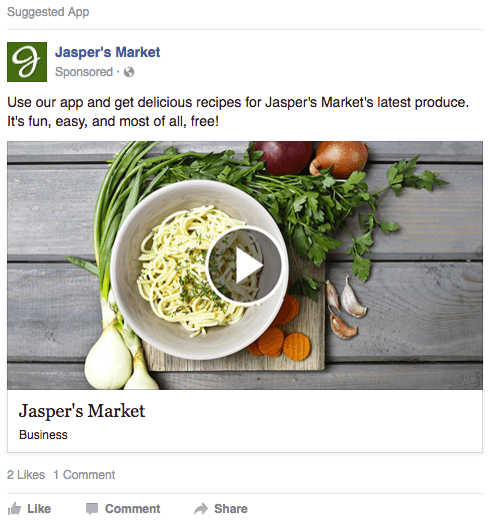
Single video ads are available on both desktop and mobile. However, only mobile video ads automatically play when they load on a user’s screen – on desktop, video ads are user-initiated.
As of February 2017, News Feed video ads also autoplay sound on mobile, fading in and out as the user scrolls (which doesn’t apply for users with their phones set on silent).
Single Video Format Specifications
According to Facebook, the recommended specifications the Single Video ad format are:
- Format: .MOV, .MP4 or .GIF files
- Resolution: at least 720p
- File size: 2.3 GB max
- Recommended aspect ratio: square (1:1)
- Instagram Feed: 60 seconds max
4. Slideshow
 The Slideshow ad format is a hybrid between photo and video ads which allow you to upload up to 10 images which you can compile into a looping video ad for both desktop and mobile.
The Slideshow ad format is a hybrid between photo and video ads which allow you to upload up to 10 images which you can compile into a looping video ad for both desktop and mobile.
One big benefit of slideshow ads is that they are less demanding in terms of bandwidth, so that Facebook users with poor connection quality can still view this “lightweight video” option, making it especially worth testing for campaigns targeting developing countries.
Another big benefit of slideshow ads is they require much less resources to produce than video ads, and are easy to produce in Facebook’s platform. All you have to do is upload three or more still images to the UI, choose audio from Facebook’s library and set the length of the video (ranging from 5-15 seconds).
Despite being much easier and less resource-heavy to produce, so far we have seen slideshow ads perform on par with video ads in our accounts, indicating that they’re certainly worth testing.
Slideshow Format Specifications
According to Facebook, the recommended specifications for the Slideshow ad format are:
- Use high-resolution images or a video file to create a slideshow
- Recommended News Feed image size: 1,280 x 720 pixels
- Recommended aspect ratio: widescreen (16:9)
- Facebook and Instagram: 50 seconds max
- Text: 90 characters (longer posts may be truncated on small screens)
- Images of same size and aspect ratio are recommended to avoid cropping
5. Canvas
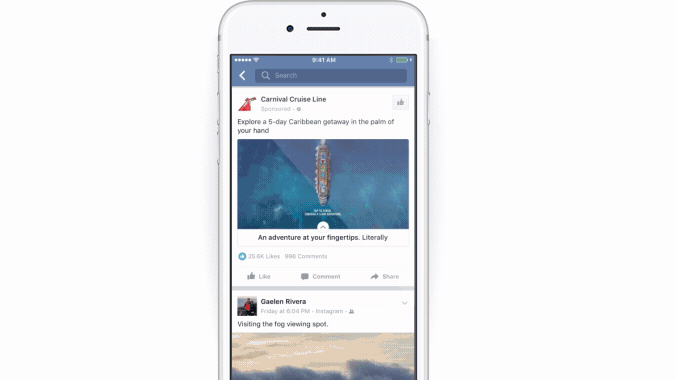
Canvas ads are a somewhat new ad format that Facebook introduced in February 2016 as a way to provide a mobile-optimized ad experience that is “post-click, full-screen, immersive” and “loads nearly instantaneously”.
Canvas ads are essentially meant to be miniature versions of external website landing pages that open within the Facebook app itself, eliminating the need for mobile users to be transported out to an external website which may be slower to load (which is a top cause of site abandonment, something that negatively impacts conversion rate).
Canvas ads can contain images, videos and text for the “immersive” experience. The versatility of this mobile-only format should make the potential value clear, but the level of complexity introduces a host of new variables for optimization purposes that don’t exist for ad formats with simpler creative. Landing page optimization is a complicated subject in itself, and Canvas ad optimization may take on some of the same elements.
Canvas Format Specifications
According to Facebook, the recommended specifications for the Canvas ad format are determined by the constituent images, slideshows and videos.
Images
- Recommended image size:1200 x 628 pixels
- Image ratio: 1.91:1
- To maximize ad delivery, use an image that contains little or no overlaid text.
Videos
- Format: .MOV, .MP4 or .GIF files
- Resolution: at least 720p
- File size: 2.3 GB max
- Recommended aspect ratio: square (1:1)
- Instagram Feed: 60 seconds max
Slideshows
- Use high-resolution images or a video file to create a slideshow
- Recommended aspect ratio: widescreen (16:9)
- Facebook and Instagram: 50 seconds max
6. Collection
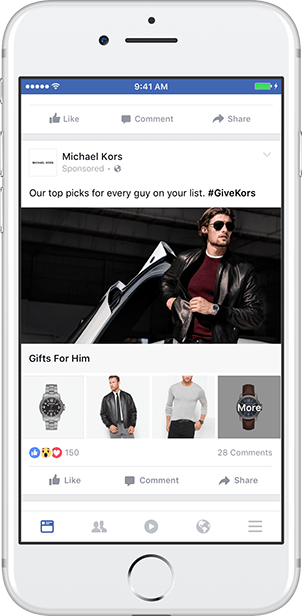
The collection ad format is very new, having been announced by Facebook in late March 2017. The ad format is intended to improve the shopping experience on mobile post ad-click, which otherwise usually includes transport to an external mobile website implying long load times.
As with Canvas Ads, Collection Ads have a post-click component: when a user clicks on the ad, the are taken to an “immersive shopping experience” which can include up to 50 product images that are linked to the corresponding product page on a company’s website.
Pre-click, Collection Ads display in Mobile News Feeds with one hero image or hero video thumbnail followed by four product images underneath it. It is easy to set up since you simply choose a product set with a product catalog you wish to advertise with the collection, and Facebook automatically creates the ad.
Collection Format Specifications
According to Facebook, the recommended specifications for the Collection ad format are determined by the constituent images, slideshows and videos (just as with Canvas ads).
Images
- Recommended image size:1200 x 628 pixels
- Image ratio: 1.91:1
- To maximize ad delivery, use an image that contains little or no overlaid text.
Videos
- Format: .MOV, .MP4 or .GIF files
- Resolution: at least 720p
- File size: 2.3 GB max
- Recommended aspect ratio: square (1:1)
- Instagram Feed: 60 seconds max
Slideshows
- Use high-resolution images or a video file to create a slideshow
- Recommended aspect ratio: widescreen (16:9)
- Facebook and Instagram: 50 seconds max
Recap
There are three basic components involved in choosing a Facebook ad type: the campaign marketing objective, placements and ad formats. Different ad formats and placements have different advantages and disadvantages that you should weigh in the context of your marketing goals while choosing which ad types to run. No single ad type is best for everyone.
Each campaign marketing objective allows for a different range of options of ad formats and placements. If you want to use a particular ad format or placement for a campaign, you’ll have to work backwards and choose the most fitting campaign objective. Facebook’s recommended objective may not always be the best way to achieve your goals in practice.
Here’s a comprehensive matrix covering all campaign marketing objectives that Facebook currently offers, so you can see a summary of all your options in one place:
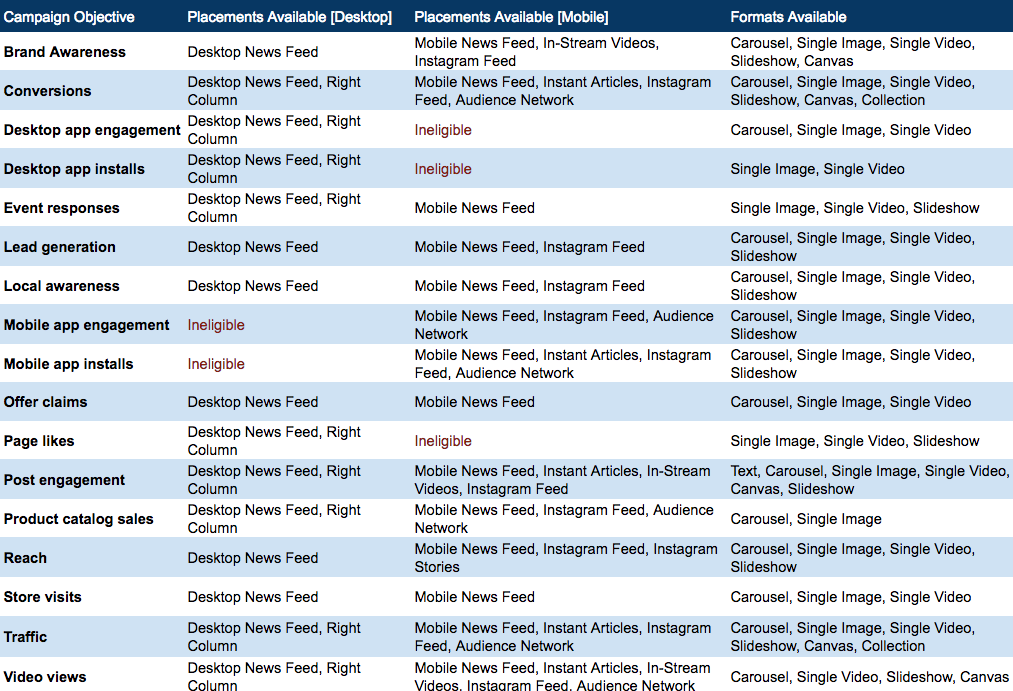




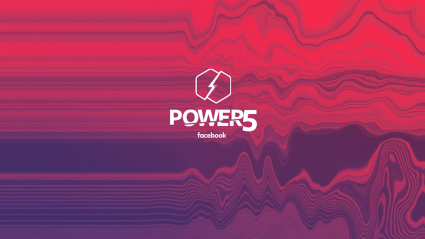
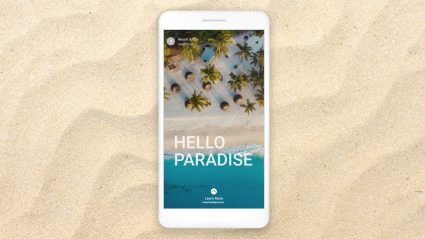

Responses